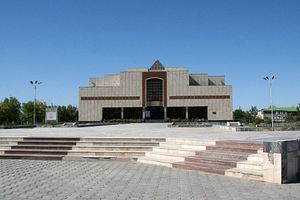Marinika Babanazarova took over the Karakalpak Museum of Art in Nukus, Uzbekistan in 1984 after the museum’s creator, Igor Savitsky, passed away. Monday, after 31 years guarding the collection of Soviet art gathered at the remote museum, Babanazarova was suddenly dismissed from her position as guardian of more than 90,000 pieces of Russian and Central Asia art and artifacts.
“I have been sacked,” she told the New York Times via telephone. In an interview with the BBC, Babanazarova said the decision to fire her came as a “complete surprise” and while no official reason was given, she links the decision to recent accusations that she stole original paintings and replaced them with forgeries. She called the charges “absurd,” and said they were “an attempt to discredit the museum’s leadership. Somebody just wants to remove me.”
Staff and patrons of the museum, which is located in western Uzbekistan’s autonomous region of Karakalpakstan, have risen up in Babanazarova’s defense. In an impassioned statement, the staff of the museum write that they do not doubt her honesty and assert that the collection remains intact.
The museum–also known as Nukus Museum–is proudly home to to the second-largest collection of Russian avant garde art after the Russian Museum in St. Petersburg as well as an extensive collection of Central Asian art and artifacts. The museum owes its existence to Igor Savitsky, a Russian artist born in Kiev in 1915. He first traveled to Karakalpakstan in the 1950s as part of the Khorezm Archaeological and Ethnographic Expedition. Nukus–which was chosen as a chemical testing site by the Soviet Union, closing the city to outsiders–is south of what remains of the Aral Sea, near the border with Turkmenistan.
“He fell in love with Karakalpakstan,” said Babanazarova told Al Jazeera earlier this year.
Savitsky, the artist for the archeological expedition, began collecting pieces and stayed in the region after the expedition’s end. The museum credits Savitsky’s interest in local folk art and artifacts as one reason he was able to get away with also collecting art that had been banned by Stalin in the 1930s. From Mansur Mirovalev’s May profile of the museum for Al Jazeera:
In the 1910s, Russian avant-garde art was a vortex of trailblazing movements that considered Picasso obsolete, and were first to develop abstractionism and helped shape last century’s artistic canon.
After the 1917 revolution, the communists longing to uproot “bourgeois” traditions supported the competing diversity of iconoclastic artists.
But by the early 1930s, Soviet dictator Joseph Stalin ordered the propagation of Communist Party-approved socialist realism in the arts.
Savitsky founded the museum in 1966 and directed it until his death in 1984. It wasn’t until the dissolution of the Soviet Union that Savitsky’s collection gained international attention and acclaim, but Uzbekistan has been reluctant to allow the collection to be exhibited outside the country.
Babanazarova’s recent dismissal is not the first attempt to push her aside. In 2011, after an American-made documentary profiled the museum (The Desert of Forbidden Art), Babanazarova described to the New York Times the increased pressure from the government the museum and its staff had come under because of increasing international attention and contacts. In the 2011 article, Babanazarova says her staff underwent 15 government audits in the span of a year, “in which they have repeatedly been asked to explain their travels overseas and the nature of their contacts” with foreigners:
“We have to prove that we are doing something good for the country, that we are not a gang of bandits,” said Ms. Babanazarova, 55, who has run the museum since Mr. Savitsky’s death in 1984. “It’s a great satisfaction that we are getting international recognition. On the other hand, it complicates our lives, to be honest.”
Andrei Volkov, a Russian artist whose grandfather’s works are among the pieces gathered by Stavisky in Nukus, was interviewed by the New York Times recently. He says Babanazarova’s current troubles were a “shock for us.”
He attributed the charges to professional rivalries, as well as to private collectors and government authorities who, he said, want to get their hands on the museum’s collection.
In the 2011 article, Babanazarova recounted stories of collectors with “bags of money” who arrived at the museum after hearing about the collection. She said that while some encouraged her to sell pieces she feared that “one sale would prompt the government to auction off the best works.”
What happens next is unclear but the timing is tragic. The museum is currently celebrating the 100th birthday of its founder, who worked with and then picked Babanazarova as his successor.

































